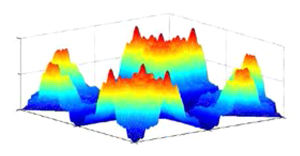Detection of COPD’s auscultative symptoms using higher order statistics in the analysis of respiratory sounds
DOI:
https://doi.org/10.3103/S0735272716020059Keywords:
lung sounds, COPD, bicoherence coefficient, skewness coefficient, kurtosis, bifrequenciesAbstract
In this paper we present the method for determination of the specific auscultatory diagnostic signs in patients with chronic obstructive pulmonary disease (COPD), which is based upon the utilization of the polyspectral analysis and the calculation of higher order statistics. The main stages of the method are the calculation and construction of the bicoherence function of the lung sound signal in order to find its maximal value. The visual and numerical estimations of the obtained maximum allow us to conclude the presence or absence in this lung’s audio signal of the artifact, which indicates the pathology. For more accurate results one needs to determine asymmetry coefficient and to perform the estimation of bifrequency corresponding to the maximal value of the bicoherence coefficient. The calculation of skewness and kurtosis coefficients of cross-correlation functions of lung sound signals, which were recorded simultaneously in four channels, allows us to reduce the sensitivity of the method to noise components. Therefore, by analyzing all proposed calculated characteristics and parameters one can conclude the presence or absence of the pathology in this audio signal.References
- Global strategy for the diagnosis, management and prevention of chronic obstructive pulmonary disease. Global initiative for Chronic Obstructive Lung Disease (GOLD). Updated 2014, http://www.golodcopd.com/.
- BASANETS, A.V.; YERMAKOVA, O.V.; MAKARENKOV, A.P.; MAKARENKOVA, A.A. Objective assessment of breath sounds in patients with COPD. Ukrainskii Zhurnal z Problem Medytsyny Pratsi, 2010, n.3, p.47-55, http://opb.org.ua/id/eprint/2587.
- AMARAL, J.L.M.; FARIA, A.C.D.; LOPES, A.J.; JANSEN, J.M.; MELO, P.L. Automatic identification of Chronic Obstructive Pulmonary Disease based on forced oscillation measurements and artificial neural networks. Proc. of IEEE Annual Int. Conf. on Engineering in Medicine and Biology Society, EMBC, 31 Aug.–4 Sept. 2010, Buenos Aires. IEEE, 2010, p.1394-1397, DOI: http://dx.doi.org/10.1109/IEMBS.2010.5626727.
- IONESCU, C.M.; DE KEYSER, R. Relations between fractional-order model parameters and lung pathology in chronic obstructive pulmonary disease. IEEE Trans. Biomed. Eng., Apr. 2009, v.56, n.4, p.978-987, DOI: http://dx.doi.org/10.1109/TBME.2008.2004966.
- BADNJEVIC, A.; CIFREK, M.; KORUGA, D. Integrated software suite for diagnosis of respiratory diseases. Proc. of EUROCON, 1-4 July 2013, Zagreb. IEEE, 2013, p.564-568, DOI: http://dx.doi.org/10.1109/EUROCON.2013.6625037.
- SORENSEN, L.; NIELSEN, M.; PECHIN, LO; ASHRAF, H.; PEDERSEN, J.H.; DE BRUIJNE, M. Texture-based analysis of COPD: A data-driven approach. IEEE Trans. Med. Imaging, Jan. 2012, v.31, n.1, p.70-78, DOI: http://dx.doi.org/10.1109/TMI.2011.2164931.
- SONG, G.; BARBOSA, E.; TUSTISON, N.; GEE, J.; GEFTER, W.B.; KREIDER, M.; TORIGIAN, D.A. Computational analysis of HRCT images for characterization and differentiation of ILD and COPD. Proc. of IEEE Int. Symp. on Biomedical Imaging: From Nano to Macro, ISBI, 28. Jun.–1 Jul. 2009, Boston, MA. IEEE, 2009, p.999-1002, DOI: http://dx.doi.org/10.1109/ISBI.2009.5193223.
- HOSSEINI, M.P.; SOLTANIAN-ZADEH, H.; AKHLAGHPOOR, S. A novel method for identification of COPD in inspiratory and expiratory states of CT images. Proc. of 1st Middle East Conf. on Biomedical Engineering, MECBME, 21-24 Feb. 2011, Sharjah. IEEE, 2011, p.235-238, DOI: http://dx.doi.org/10.1109/MECBME.2011.5752109.
- MAKARENKOVA, A.A. Investigation and objectifying of adventitious breath sounds in the patients with chronic obstructive pulmonary disease. Acoustic Bulletin, 2010, v.13, n.3, p.31-41, http://hydromech.org.ua/content/uk/av/13-3_31-41.html.
- ZHANG, JIANMIN; SER, WEE; YU, JUFENG; ZHANG, T.T. A novel wheeze detection method for wearable monitoring systems. Proc. of Int. Symp. on Intelligent Ubiquitous Computing and Education, 15-16 May 2009, Chengdu. IEEE, 2009, p.331-334, DOI: http://dx.doi.org/10.1109/IUCE.2009.66.
- AYDORE, S.; SEN, I.; KAHYA, YASEMIN P.; MIHCAK, M.K. Classification of respiratory signals by linear analysis. Proc. of IEEE Annual Int. Conf. on Engineering in Medicine and Biology Society, EMBC, 3-6 Sept. 2009, Minneapolis, MN. IEEE, 2009, p.2617-2620, DOI: http://dx.doi.org/10.1109/IEMBS.2009.5335395.
- MARSHALL, A.; BOUSSAKTA, S.; PEARSON, S.B. Applications of signal recognition algorithms to diagnosis and monitoring in chest medicine. Proc. of 3rd IEE Int. Seminar on Medical Applications of Signal Processing, (Ref. No. 2005-1119), 3-4 Nov. 2005. IET, 2005, p.121-124, http://ieeexplore.ieee.org/xpl/articleDetails.jsp?reload=true&arnumber=1543130.
- TAPLIDOU, S.A.; HADJILEONTIADIS, L.J. Analysis of wheezes using wavelet higher order spectral features. IEEE Trans. Biomed. Eng., Jul. 2010, v.57, n.7, p.1596-1610, DOI: http://dx.doi.org/10.1109/TBME.2010.2041777.
- NOVIKOV, A.K. Polyspectral Analysis. St. Petersburg: Acad. A. N. Krylov CRDI, 2002 [in Russian].
- POREVA, ANNA; KARPLYUK, YEVGENIY; MAKARENKOVA, ANASTASIIA; MAKARENKOV, ANATOLIY. Detection of COPD’s diagnostic signs based on polyspectral lung sounds analysis of respiratory phases. Proc. of IEEE 35th Int. Sci. Conf. on Electronics and Nanotechnology, ELNANO, 21-24 Apr. 2015, Kyiv, Ukraine. IEEE, 2015, p.351-355, DOI: http://dx.doi.org/10.1109/ELNANO.2015.7146908.

Downloads
Published
2016-02-20
Issue
Section
Research Articles

